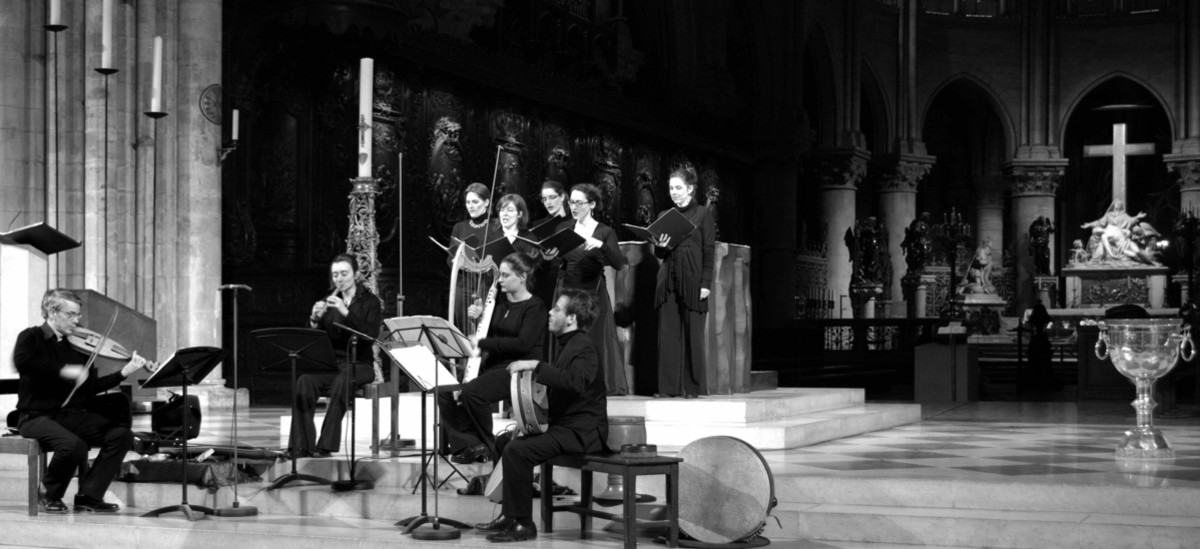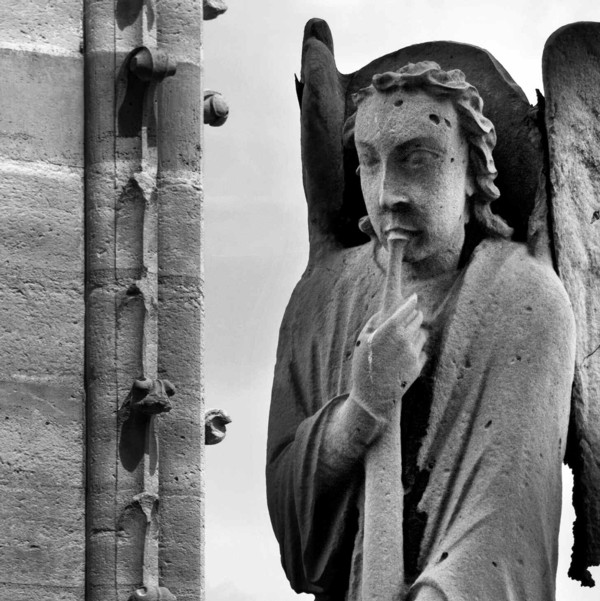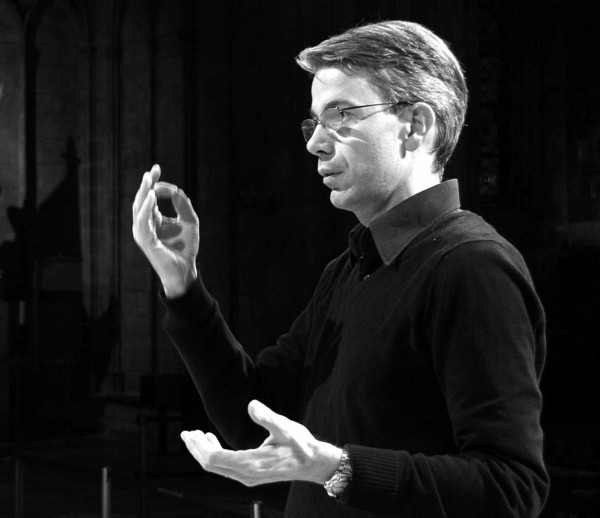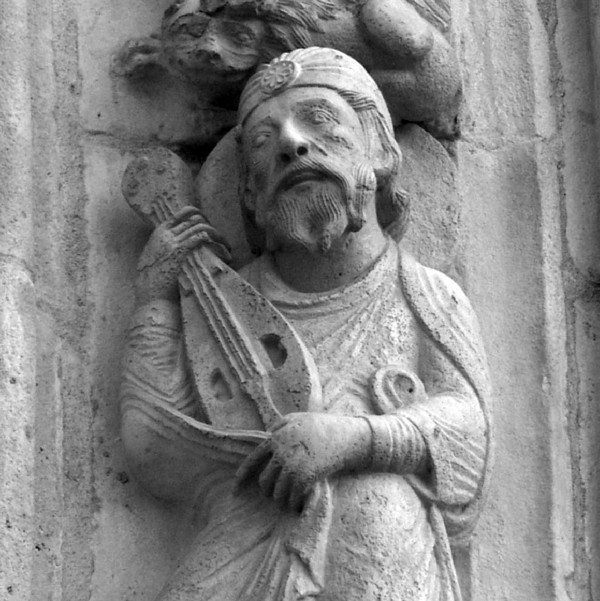
medieval.org
musique-sacree-notredamedeparis.fr
Maîtrise Notre-Dame de Paris 003
2012
Mater Salvatoris
Maîtrise Notre-Dame de Paris. Ensemble vocal de Notre-Dame de Paris

medieval.org
musique-sacree-notredamedeparis.fr
Maîtrise Notre-Dame de Paris 003
2012
1ère partie
1. Ave maris stella [3:08]
hymne grégorienne — LR|tutti
Paris, Bibliothèque Nationale de France, manuscrit latin 15181 ·
Antiphonaire parisien du XIIIème siècle dit « de la Sorbonne »
2. Ave beatissima ~ Ave Maria ~ [Ave maris stella] [0:55]
motet à 3 voix
Codex Montpellier —
CA|RM|LR
3. O Maria, stella maris [4:28] prose |
ADAM de SAINT-VICTOR († ap. 1146), De Beata Maria
Paris, Bibliothèque Nationale de France, manuscrit latin 14452 ·
Prosaire victorin du XIIIème siècle —
CM|tutti
4. Ave maris stella [3:03] conduit à 3 voix
ms Pluteus 29.1 —
CD|LR|RM
5. Salva nos stella maris [2:27] rondeau
ms Pluteus 29.1 —
CA|tutti · SR|SD|BS|RM
2ème partie
6. Muito a santa Maria [10:18]
cantiga de santa Maria n° 202 |
ALPHONSE X le SAGE, (1221-1284) ·
CSM 202
El Escorial, Real monasterio, j.b.2 (E codex —
CD|CA|tutti · BS|SD|SR|RM
7. Ibo Michi [3:16] antienne —
Tutti
Paris, Bibliothèque Nationale de France, manuscrit latin 14816 ·
Antiphonaire parisien de l’abbaye de Saint-Victor, XIIIème siècle
8. Salve mater salvatoris [6:18] prose |
ADAM de SAINT-VICTOR († ap. 1146), Nativité de Marie
Paris, Bibliothèque Nationale de France, manuscrits latins 14452 et 14819 ·
Prosaires victorins du XIIIème siècle —
Tutti
9. Marie assumptio ~ Huius chori [3:15] motet à 3 voix
Codex Montpellier —
CD|CA|RM · SR|BS|SD
10. O Maria virginei [4:56] conduit à 3 voix |
PHILIPPE LE CHANCELIER (ca .1165 - 1236)
ms Pluteus 29.1 —
CD|LR|RM
11. Beata viscera [5:19] conduit à 1 voix |
PHILIPPE LE CHANCELIER (ca .1165 - 1236) —
PÉROTIN († ap. 1238 ?)
ms Pluteus 29.1 —
RM · SD
12. Entendez tuit ensemble [7:28] chanson |
GAUTIER DE COINCY (1177-1236), Les Miracles de Nostre-Dame
ms de Soissons —
LR · BS|SR|SD|RM
3ème partie
13. Estampie royale n° 8 [2:45]
Bibliothèque Nationale de France, manuscrit français 844 ·
Manuscrit dit « du Roi », XIIIe siècle —
SR|SD|BS|RM
14. Virge glorieuse [8:02] lai
Paris, Bibliothèque de l’Arsenal, 3517 ·
Manuscrit du XIIIème siècle —
LR|CM · BS|SD|SR|RM
15. Dieus comment|O regina|Nobis concedas [2:52] motet à 3 voix
Codex Montpellier —
CD|CM|RM · SR|SD|BS
16. Hui matin a l’ajournee [5:33] chanson |
GAUTIER DE COINCY (1177-1236), Les Miracles de Nostre-Dame
ms de Soissons —
CA|tutti · SR|SD|BS|RM
17. Benedicamus Domino [4:42] organum à 3 voix
ms Pluteus 29.1 —
CA|CM|LR|tutti
Codex Montpellier:
Montpellier, Bibliothèque de la Faculté de Médecine H 196
Manuscrit de l’Ars antiqua, fin XIIIème siècle
ms Pluteus 29.1:
Florence, Biblioteca Medicea-Laurenziana Pluteus 29.1
Manuscrit parisien de l’École de Notre-Dame, XIIIème siècle
ms de Soissons:
Paris, Bibliothèque Nationale de France,
manuscrit français, nouvelle acquisition 24541
Manuscrit de Soissons, XIVe siècle

Ensemble vocal de Notre-Dame de Paris
Sylvain Dieudonné
Cécile Achille (CA)
Cécile Dalmon (CD)
Marthe Davost (MD)
Raphaël Mas (RM)
Clara Morel-Coutouly (CM)
Lucile Richardot (LR)
Instruments
Solène Riot (SR) — Cornet à bouquin, flûtes - Cornetto, Flutes
Bérangère Sardin (BS) — Harpe gothique - Gothic harp
Sylvain Dieudonné (SD) — Vièles
médiévales à archet - Bowed Medieval
fiddle « vièle »
Raphaël Mas (RM) — Percussions - Percussions
Flûtes
flûte à bec ténor en DO, modèle Rafi de Francesco Li Virghi ;
flûte à bec soprano en DO, modèle Ganassi de Jean Luc Boudreau ;
flûte à bec alto en SOL, modèle Ganassi de Jean Luc Boudreau ;
flûte traversière renaissance ténor en RÉ de Giovanni Tardino.
Flutes:
Tenor recorder in C, Rafi model, by Francesco Li Virghi ;
Soprano recorder in C, Ganassi model by Jean Luc Boudreau ;
Alto recorder in G SOL, Ganassi model by Jean Luc Boudreau ;
Tenor Renaissance transverse flute in D by Giovanni Tardino.
Cornet muet de Serge Delmas.
Cornetto mutto by Serge Delmas.
Harpe gothique du facteur R. Thurau, 1985.
Gothic harp by R. Thurau, 1985.
Vièles médiévales à archet
vièle à 5 cordes réalisée d'après
les scuptures du portail royal de la cathédrale de Chartres,
Olivier Pont 2008 ;
vièle à 5 cordes réalisée d'après
d'une fresque de l’église « Santa Maria Novella
» à Florence, XIVe siècle, Olivier Pont 2010.
Bowed medieval viele:
5-string viele after instruments carved in stone and decorating the Royal Portal of Chartres Cathedral, by Olivier Pont 2008 ;
5-string viele after an instrument on a 14th-century fresco in Santa
Maria Novella Church in Florence, by Olivier Pont 2010.
Percussions
tambours sur cadre de chez Eckerman, bendir, tambourin, zarb.
Percussions: frame drums by Eckerman, bendir, tambourine, zarb.

Remerciements
à
• Prise de son : Isabelle Davy et Alix Ewald
• Montage, mixage et mastering : Isabelle Davy
• Direction Artistique : Sylvain Dieudonné et Emmanuel Conquer
• Conception du programme et transcription des pièces : Sylvain Dieudonné
• Conception graphique : Jérôme Dumoux • myArtDesign.fr
• Photographies : © NDP, J. Dumoux
• Traductions : Geneviève Bégou
• Direction du label : Simon Cnockaert
Enregistré à Paris du 18 au 24 avril 2012 en la chapelle de l'hôpital Notre-Dame du Bon Secours
Motif couverture, livret et CD : Provenance: Bibliothèque Interuniversitaire de Montpellier. BU de médecine
Crédit photographique : Service Photographie de la BIU
Musique Sacrée à Notre-Dame de Paris • 39, boulevard Saint-Germain 75005 Paris
www.musique-sacree-notredamedeparis.fr • contact@msndp.com
© MSNDP - 2012
Au tournant des XIIe et XIIIe siècles, Paris est en pleine effervescence
: chantier de la cathédrale Notre-Dame, entrepris par Maurice de Sully
en 1163, création de l'Université, mais aussi composition des grandes
polyphonies de l'École de Notre- Dame. C'est également l'époque de la
poésie et de la piété mariale qui prend alors de nouvelles formes
d'expression. Les proses d'Adam de Saint-Victor († ap. 1146), ancien precentor
(premier chantre) de la cathédrale, sont intégrées à tous les missels
[cf. n°3 & 8]. À sa suite domine la personnalité de Philippe,
chancelier de Notre-Dame (env. 1165-1236) [n°10], mêlant parfois son art
à celui de Pérotin († 1238 ?), succentor (sous-chantre) de la
cathédrale et principal représentant de l'École de Notre-Dame [n°11].
Gautier de Coincy (1177-1236), prieur de l'abbaye de Vic-sur-Aisne,
perfectionne l'art du contrafactum et s'inspire d'œuvres parisiennes
comme support mélodique aux vers français de ses Miracles de Notre-Dame
[cf. n°12 & 16]. En Espagne, le roi Alphonse X « le Sage
» (1221-1284) raconte, dans l'un de ses quelques 400 Cantigas de santa Maria [cf. n°6], la composition de l'une des œuvres les plus célèbres d'Adam de Saint-Victor, la prose Salve mater salvatoris [n°8] : le poète, resté sans inspiration face à une rime qui lui manque, demande à Marie d'achever pour lui cette prose. Marie accède à sa demande, car elle a grand désir d'aider ceux qui chantent des proses composées pour sa louange. Ainsi apparaît la rime nobile triclinium
présentant Marie comme réceptacle de la Trinité divine qui, par elle,
prodigue son amour aux hommes. Cette image forte et novatrice dans sa
concision alterne, au sein de la prose elle- même, avec des figures plus
traditionnelles comme celle de Marie étoile de la mer...
L'hymne Ave maris stella [n°1], composée au
VIIIe siècle, semble servir de modèle à toute la
poésie mariale des siècles suivants. En chantant la douce mère de Dieu (Dei mater alma), elle met en avant la maternité divine de Marie, mère sans égale [n°5]. À ce titre, elle est celle qui renforce l'alliance entre Dieu et les hommes [n°11]. Si l'Ave
de la salutation de l'archange Gabriel est le point de départ de
nombreuses prières adressées à Marie (cf. Ave Maria [n°2, duplum]), l'hymne précise : en accueillant cet Ave… tu as inversé le nom d'Ève. Ave / Eva, ce jeu de mots ne pouvait que trouver un écho favorable chez Gautier de Coincy, grand amateur du genre : Ève nous a livrés à la mort… mais Ave nous a tous délivrés, amplifiant aussi le jeu des sonorités : Et Eve aporta ve (Ève nous a apporté le malheur) / Et mist a port Ave (« Ave » nous a menés à bon port) [n°12]. Mais Marie est également la mère sans homme [n°5] dont est chantée l'intégrité après l'enfantement [n°11], la Vierge unique, douce entre tous [n°1], la fleur de la dignité virginale
[n°10]... La poésie des XIIe et XIIIe siècles a ouvert la voie à un
forme de prière litanique extrêmement riche et imagée. En témoignent la
prose Salve mater salvatoris [n°8] d'Adam de Saint-Victor, largement inspirée du Cantique des cantiques (cf. l'antienne Ibo michi [n°7]), ou bien la séquence à trois voix O Maria virginei
[n°10] de Philippe Le Chancelier qui a remarquablement su fédérer les
valeurs sonores de la poésie avec celles de la musique. En français, le
lai Virge glorieuse [n°14], contrafactum anonyme d'une
séquence monodique du même Philippe le Chancelier, témoigne aussi d'un
imaginaire riche et inventif.
Aucun terme n'est assez beau pour chanter la Dame gracieuse
[n°14]. Si l'influence de la poésie courtoise est
indéniable, les limites sont néanmoins fixées : il voit mal, il entend mal, celui qui délaisse Marie pour Marot
[n°16] prévient Gautier de Coincy, réadaptant un motet profane qui
chantait les mérites de ladite Marot, motet lui-même extrait d'un
organum de l'École de Notre-Dame (Benedicamus Domino [n°17]).
Les poésies médiévales contiennent également de nombreuses prières d'intercession : ne tarde pas à prendre en pitié ce monde en perdition [n°3], ceci dans le but de nous conformer au Christ :
toi qui nous conduis et mènes au Seigneur
Jésus… par ton amour raccorde-nous à Jésus ! [n°14]. Enfin, le poète n'hésite pas à inclure les chantres dans sa demande : visite et réconcilie ce chœur [n°15], reçois les chants de ce chœur, mère glorieuse du Sauveur [n°9].
Sylvain Dieudonné
The turn of the 13th century was a time of intense building activity in
Paris: the construction of Notre-Dame cathedral had started in 1163
under the supervision of Maurice de Sully. But the city was also a
flourishing center of cultural and intellectual life that saw the
foundation of the university and the composition of the first
polyphonies of the Notre-Dame School… Around that time, one witnesses a
marked evolution in poetic genres expressing Marian devotion. The prose
of Adam de Saint-Victor († after 1146), a former cantor at the
cathedral, is included in the Missal [cf. n°3 & 8]. Another
influential figure is Philip the Chancellor, a chancellor of Notre-Dame
(ca. 1165-1236) [n°10], who sometimes collaborated with Pérotin (†
1238?), succentor of the cathedral and the most famous member of
the Notre-Dame School [n°11]. Gautier de Coincy (1177-1236), prior of
the abbey of Vic-sur-Aisne, brought the art of contrafactum to perfection and set his Miracles de Notre-Dame to music [cf. n°12 & 16], drawing inspiration from Parisian melodies. In one of his more than 400 cantigas de santa Maria
[cf. n°6], the Spanish King Alfonso X “the Wise” (1221-1284) describes
the composition of one of Adam de Saint-Victor’s most famous piece: the
prose Salve mater salvatoris [n°8]: as inspiration fails him, the poet begs Mary to finish this prose for him. Mary agrees, for she is eager to help those who sing prose in her praise. She inspires him with nobile triclinium,
a powerful, concise and innovative image presenting her as the sacred
vessel through which the Holy Trinity lavishes divine love on mankind.
More traditional imagery also describes Mary star of the sea…
Almost all later Marian poetry is modeled after the 8th century hymn Ave maris stella [n°1]. By praising the Lord’s sweet mother (Dei mater alma), the hymn highlights the divine maternity of Mary, the peerless mother [n°5]. As such, she strengthens the covenant between God and mankind [n°11]. The greeting of the Archangel Gabriel - Ave - opens many Marian prayers (cf. Ave Maria [n°2, duplum]). And the hymn goes on: receiving this Ave…you transformed the name of Eva. Ave / Eva, this play on words could not but inspire Gautier de Coincy, himself a master of the genre: Ève nous a livrés à la mort… mais Ave nous a tous délivrés, (Eva sent us to our death… but Ave set us all free) with an additional play on sound: Et Eve aporta ve (Eva brought us evil) / Et mist a port Ave ("Ave"brought us back safely to shore) [n°12]. Mary is also the mother [who conceived] without a man [n°5] the virgin who remained a virgin when she gave birth [n°11], the unique Virgin, meek above all others [n°1], flowering by her virginity
[n°10]… 12th and 13th-century poetry paved the way to a form of prayer
known as litanies, characterized by rich and extremely vivid imagery.
Listen to the prose Salve mater salvatoris [n°8] by Adam de Saint-Victor, largely inspired by the Song of Songs (cf. Ibo mihi [n°7]), or Philip the Chancellor’s O Maria virginei 3-part sequence [n°10] a piece most remarkable in the way it combines language and music. The French “lai” Virge glorieuse [n°14], an anonymous contrafactum of a monodic sequence by the same Philippe the Chancellor, also shows rich and inventive imagery.
Nothing is too much in praise of the graceful Lady [n°14]. Yet, while the influence of courtly poetry is manifest, it has its limits: he sees wrong and hears wrong, who turns away from Mary to go to Marot
[n°16] warns Gautier de Coincy in his adaptation of a secular motet
praising the merits of a certain lady called Marot. The motet itself
originated from a Notre-Dame School organum (Benedicamus Domino [n°17]).
Medieval poetry also includes many prayers of intercession: make haste and take pity on this troubled world [n°3], so that we may follow the example of Christ: you who lead us to the kingdom of the Lord Jesus… may your love reconcile us to Jesus! [n°14] The cantors themselves are not forgotten: inspire this choir [n°15], hear this choir singing, glorious mother of the Redeemer [n°9].
Sylvain Dieudonné
 Sylvain Dieudonné
Sylvain Dieudonné
Sylvain Dieudonné studied violin at
Versailles Conservatoire then joined the Paris Conservatoire National
Supérieur in 1988, where he graduated in harmony, counterpoint, fugue,
orchestration, analysis and choir conducting, specializing in Gregorian
chant and musical paleography with Canon Jean Jeanneteau, Dom Jean
Claire and Dom Saulnier at Saint-Pierre de Solesmes Abbey. Sylvain
Dieudonné also plays the bowed medieval fiddle (viele).
In 1994,
he was appointed choirmaster at Notre-Dame de Paris Choir School
(Maîtrise de Notre-Dame). Head of the medieval music department, he
coordinates pedagogy programs, research, concerts and liturgical
services. The weekly singing of the Gregorian mass ensures the
continuity and presence of this repertoire in France’s most famous
cathedral. Sylvain Dieudonné’s mission is also to ensure quality
artistic programming throughout the concert season. As the medieval
music department develops its activities and projects, involving the
various Maîtrise choirs he coaches (respectively Children, Youth and
Adult Choirs), Sylvain Dieudonné has developed multiple collaborations
with renowned musicians and ensembles such as Brigitte Lesne (Alla
Francesca), Dominique Vellard, Marie-Noël Colette, Antoine Guerber
(Diabolus in musica) or Jean-Yves Hameline.
Besides his teaching
and conducting activities, Sylvain Dieudonné devotes much of his time to
musicological research with a focus on the study of manuscript sources,
especially the Notre-Dame School repertoire. He has reconstructed works
that are brought back to life through concert performances and
recordings under his direction in France and abroad.
The Notre-Dame de Paris Vocal Ensemble
A
distinct entity within the music department of the Cathedral, the
Notre-Dame de Paris Vocal Ensemble is a group of professional singers
trained at Notre-Dame Choir School (Maîtrise). They focus on sacred
repertoire spanning medieval to contemporary eras, and combine
performance practice and musicological research. A major feature in the
Notre-Dame concert series, the ensemble also performs throughout France
and abroad. Concert programs always integrate the spatial, acoustic,
historical and sacred dimension of the concert venue itself.
 Music at Notre-Dame de Paris Music
Music at Notre-Dame de Paris Music
has
been an integral part of the life of Notre-Dame Cathedral in Paris. The
magnificent polyphonies of the so-called Notre-Dame School were
composed at the time when the pointed arches of the new gothic style
rose up to the heavens to form the chancel. Vocal virtuosity echoed
daring architectural creation. Since then, the musical tradition
at
Notre-Dame has been upheld to the highest degree and each generation in
turn has added a stone to this prestigious edifice, the cathedral’s
musical history.
Conscious about this age-old heritage and the
national and international reach of Notre-Dame Choir School’s activities
and excellent musical training, the French government, the City of
Paris and the Parisian Diocesan Association teamed up and founded the Musique Sacrée à Notre-Dame de Paris association in 1991.
MSNDP
is charged with coordinating the full range of music-related activities
at the Cathedral, both at the artistic and administration level.
However, its core mission is teaching music, training singers,
organising music for liturgical celebrations and services, setting up
concerts and recitals and researching into the rich musical heritage of
the Cathedral. It also plays an important role in the creation of new
musical works and in their circulation. These projects benefit from the
provision of extensive facilities. The key element is the Choir School
of Notre-Dame (Maîtrise) composed of the Children, Youth and Adult
Choirs, the latter consisting of pre-professional singers, and the
Notre-Dame de Paris Vocal Ensemble.
The Notre-Dame de Paris Choir School
is committed to providing a fine musical education with a focus on solo
and choral singing, from beginner level to professional training. The
variety of disciplines taught, the wide range of repertoire and the many
projects in partnership with other musical institutions give this
pedagogical program its unique profile.
Throughout the annual
Notre-Dame concert season, the various choirs perform about 15 different
programs - ranging from Gregorian chant to contemporary music and the
great classics of choral repertoire - at the cathedral but also in other
venues in France and abroad. In addition to their intense concert
activity, the choirs are also involved in the cathedral’s life of prayer
and worship.
Several recordings document the many projects of
the Notre-Dame de Paris Maîtrise choirs and showcase their stylistic
diversity. In addition, the great organ, the choir organ and their
titular organists factor in the musical profile of the Cathedral and its
choirs.
